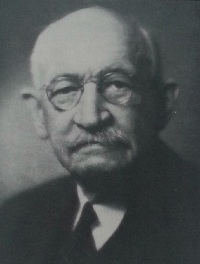Frederick E. Turneaure

Biography
Frederick E. Turneaure
Teacher – Consultant – Administrator – Author – Committeeman
Structural Engineering – Education – Public Service – Construction – Bridges
Eighth National Honor Member Nominated by the Cornel University Chapter
In engineering circles, wherever engineering texts and reference books are in use, Frederick Eugene Turneaure will be remembered for his contributions in the widely separated fields of framed steel structures, water supply and reinforced concrete construction. Born July 30, 1866, on a farm in northern Illinois, near Freeport, he began his career in engineering when he graduated from Cornell University in 1889, with the degree of bachelor of science in civil engineering. Thereafter, until his death, March 29, 1955, he spent sixty-six active years, contributing knowledge for the expert building of his country, and passing that knowledge forward to students fortunate enough to come under his influence.
His choice of Cornell University was influenced by the receipt of a scholarship in mathematics. The years 1890-1892 were spent as instructor at the University of Washington, after which he went to Europe to extend his studies. When he returned to the United States, he was engaged by the University of Wisconsin as professor of bridge and sanitary engineering. He became Dean of the College of Mechanics and Engineering in 1903, being then only 37 years of age. A scant two years later, the University of Illinois conferred on him the honorary degree of Doctor of Engineering. Although he retired from his deanship in 1937 and became Dean Emertus, there was no distinguishable gap in his activities until his death at the age of 84 years.
In his time, Dean Turneaure was one of the world’s foremost authorities on theoretical reinforced concrete analysis, water supply, and indeterminate structures. While connected with the University of Wisconsin, he was also alderman and then city engineer of Madison (1901-1904), during a time when the first sewage treatment works were installed. A member of the Wisconsin State Highway Commission from 1911 until it was discontinued in 1929, he played a large part in developing sound policies of highway administration in the state. His acute involvement with bridges began in 1898; and this led into his later committee work for the American Railway Engineering Association (AREA) from 1908 to 1918. Working with the cooperation of the railroads, this research resulted in the historic report “Impact in Steel Railway Bridges,” the basis of the AREA Impact Formulas. He served on committees of the American Society of Civil Engineers (ASCE) with inexhaustible vigor, notably ‘Stresses in Railroad Tract,” “Impact on Highway Bridges” and “Bridge Design and Construction.” He was a member of the first Joint Committee on Concrete and Reinforced Concrete that formulated the first report standardizing reinforced concrete design. As chairman of the ASCE Committee on Research, he helped (1924-1933) to produce the report on “Steel Column Research.” With all, he had time to serve, tellingly, on the ASCE Committee on Engineering Education.
Turneaure’s writings cover a wide range of subjects, attesting to the breadth of his professional competence-bridge design, column, beams, reinforced concrete design, sanitation, water supply, etc.; ‘Theory and Practice of Modern Framed Structures,’ by Johnson, Bryan and Turneaure; and “Principles of Reinforced Concrete Design,” by Maurer and Turneaure.
Among his fraternal associations were the Western Society of Engineers (WSE), the American Society of Civil Engineers (ASCE), honorary member in 1933, the American Concrete Institute (Hon. M., ACI), and the Society for the Promotion of Engineering Education, ASEE (past president, 1908-1909). For many years, he was chairman of the Wisconsin Registration Board of Architects and Professional Engineering. His connections included the American Association for the Advancement of Science, the American Railway Engineering Association, and the Wisconsin Engineering Society (president, 1909-1910).
During his long career, in younger years as well as later, he was showered with honors. In addition to those mentioned above, he received the Turner Gold Medal from ACI in 1930 “for distinguished service in formulating sound principles of reinforced concrete design,” the Octave Chanute Medal from WSE in 1907, and the Lamme Medal in 1937 for excellence in engineering teaching.
In 1937, the Cornell chapter of Chi Epsilon nominated Dean Turneaure for election to the grade of National Honor Member; and the Council, in Conclave at Purdue University, December 18, 1936, elevated him to become its eighth National Honor Member.
Professional attributes that have been used from time to time to characterize this man are:
Dean Turneaure was a modest man of quiet and equable disposition. But his standards of professional and personal integrity were such as to permit no compromise on matters of principle; and he could be vigorously outspoken in condemnation of anything he deemed unworthy, while his own clear vision and sound judgment made him impatient of loose thinking and irresponsibility, whether in private or public affairs.
Native generosity and keen sense of social responsibility led Dean Turneaure to give freely of his time and resources to affairs outside the scope of his university duties.
He was a broadminded man of sound judgment. An educator as well as an engineer, he had the respect and faith of his fellow men wherever he met them. He applied sound engineering principles to all his work and strove, not for glory, but for the betterment of mankind.
Much can be said of the qualities of mind, the strength of character, and the friendliness of disposition which mark Dean Turneaure as a successful administrator and teacher of engineering.
